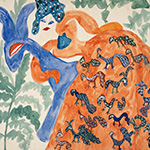The Musée d’Art Moderne de Paris invites us to rediscover the diversity of Arab modernities in the 20th century and to renew the historical perspective on artistic scenes that are still little known in Europe. Through a selection of more than 200 works, most of which have never been exhibited in France, the exhibition Présences arabes – Art moderne et décolonisation – Paris 1908-1988 highlights the relationship between Arab artists and Paris throughout the 20th century.
The exhibition explores another history of modern art, illuminated by numerous historical sound and audiovisual archives present in the exhibition. Structured chronologically, it begins in 1908, the year of the arrival of the Lebanese poet and artist Khalil Gibran in Paris and the opening of the Cairo School of Fine Arts. It ends in 1988, with the first exhibition devoted to contemporary Arab artists at the Institut du Monde Arabe (inaugurated a few months earlier) in Paris and with the exhibition Singuliers: bruts ou naïfs , with among others the Moroccan artist Chaïbia Tallal and the Tunisian artist Jaber Al-Mahjoub, presented at the children’s museum of the Musée d’Art Moderne de Paris.
As Silvia Naef, art historian and one of the authors of the catalogue of the Présences Arabes exhibition at the MAM, writes: “How to make a modern and Arab art? A real aesthetic project was put in place during the 20th century: thought of as a break with academic art, in echo with the Western avant-gardes, within the framework of a specific national identity, without returning to an Islamic art.”
The exhibition thus highlights more than 130 artists whose works constitute an essential contribution to the Arab avant-gardes and to the history of modern art of the 20th century.
It also highlights the essential role played by Paris. Described as the “capital of the Third World” by historian Michael Goebel, the city was considered from the 1920s onwards as a breeding ground for anti-colonial networks and the home of new cosmopolitan modernities.
The exhibition itinerary is built around different trajectories of artists who studied in the fine arts schools of their countries before coming to study and settle in Paris to continue their training. Throughout the 20th century, Paris was the place of access to modernity, of criticism of colonialism and the center of many meetings. The Museum of Modern Art itself played an important role in the post-war period thanks to its exhibitions (Salon des réalités nouvelles, Salon de la jeune peinture, Biennale des jeunes artistes de Paris, etc.) and the acquisitions initiated from the 1960s.
Press release from the Musée d’Art Moderne de Paris
Image: Baya. Femme en robe orange et cheval bleu. Circa 1947. Gouache, graphite crayon and ink on paper mounted on cardboard. 74,7 x 91,6 cm ©Othmane Mahieddine



